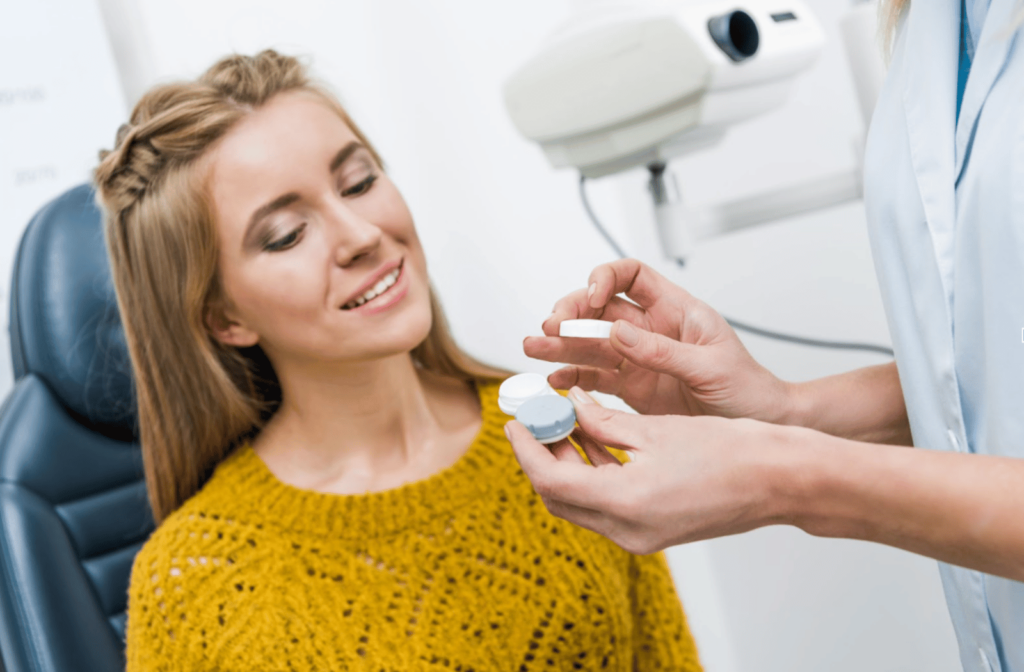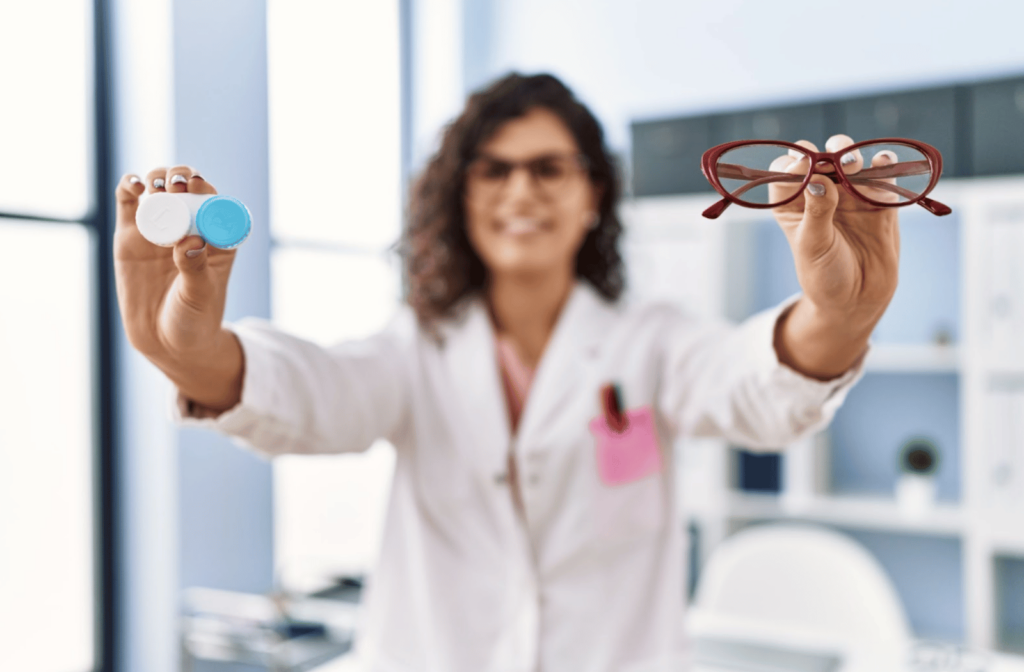Contact lenses are a go-to vision fix for many. If you’ve rocked glasses in the past, you probably already have a spot-on prescription. However, you can’t simply pick up any pair of contact lenses and expect them to work.
Glasses and contact lenses sit on your face in different positions so they don’t use the same prescription. When fitting contact lenses, your optometrist needs to get a whole new set of measurements to ensure the prescription you receive is the one you need!
Comparing Contact & Glasses Prescriptions
If contact lenses and glasses can both correct the same vision problem, why can’t we simply use the same prescription calculations? It all comes down to location, location, location! Glasses sit a couple centimetres away from your eye, which is pretty close, but not as close as contacts which sit directly on the eye. As you can imagine, this requires slightly different focusing power.
Glasses prescriptions adjust for this small distance between your eye and the lens, as it changes how light refocuses as it enters your eyes. They can also accommodate many of your unique features, such as pupillary distance—the distance between your pupils. That’s part of the reason why choosing the right frames is essential.
On the other hand, contact lenses need to fit your eyes precisely. There’s no room for error when it comes to wearing something directly on the surface of your eye. Additionally, your prescription needs to account for this proximity. A contact lens prescription may look a lot like an eyeglass prescription, but it must include a curve and diameter, which can only be measured during a contact lens fitting.
Ill-fitting contact lenses can cause discomfort or even damage your cornea. Fortunately, you don’t need to break out the tape measurer, contact lens fittings are what we do!
What Happens During a Contact Lens Fitting?
Just like how getting measured for a bespoke outfit helps it fit comfortably, the first step to clear vision with contact is an exam and fitting. This is much like any other eye check-up as we’ll take the time to see how your eyes are doing, but finish it with some extra tests to measure their shape.
We have some cool gadgets for just this purpose. A keratometer measures the curvature of your cornea to help the lenses rest on them comfortably. We can also use a slit lamp or various other diagnostic tools at our disposal to get a good look at your pupils and determine the correct lens size.
After this thorough exam, we can suggest a type of contact lens that should work for you. Don’t worry, you’re not locked into using your first pair of lenses forever. You can start with trial lenses to explore a few brands and sizes until you find the ones that fit just right. It can take a bit of time for your eyes to adjust to wearing contacts, but getting the right fit is crucial to avoid irritation, discomfort, and any long-term eye problems.

Types of Contact Lenses
There are many different types of contact lenses to choose from. They each offer their own benefits, and picking the right one comes down to your needs and preferences.
Soft Contact Lenses
Soft contact lenses are made from flexible plastics that allow oxygen to pass through to the cornea. They are generally more comfortable and easy to adapt to than the alternatives, especially for first-time users.
Rigid Gas-Permeable (RGP) Contact Lenses
Rigid gas-permeable (RGP) contact lenses are made from durable materials that provide clear, crisp vision. They are more resistant to deposit buildup and are often recommended for those with astigmatism or keratoconus.
Hybrid Contact Lenses
Hybrid contact lenses combine the hard center of RGP lenses with a soft outer ring. This way they can offer the clarity of RGP lenses with the comfort of soft lenses. The best of both worlds!
Scleral Contact Lenses
Scleral contact lenses are larger lenses that cover the white part of the eye, known as the sclera. Their size allows them to vault over the cornea and create a hydrating reservoir between the lens and the eye. This personal oasis can soothe inflammation from severe dry eyes while the gap can help people with irregular corneas.
Toric Lenses
Toric lenses are specifically designed to correct astigmatism. They’re slightly heavier at the bottom so they can orient themselves properly. They’re available in both soft and RGP materials.
Caring for Your Contacts
If you’re new to wearing contact lenses, proper care is essential to maintain eye health:
- Clean and disinfect: Always use a fresh solution to clean and store your lenses.
- Follow the replacement schedule: Stick to the prescribed replacement schedule, whether daily, bi-weekly, or monthly.
- Practice good hygiene: Wash your hands before handling lenses and avoid sleeping in them.
- Avoid water: Take your lenses out before hopping in the pool or the shower to help prevent damage or infections.
Make the Leap From Glasses to Contacts
Our Toronto Centre Eye Care team has helped many people make the switch to contact lenses. Maybe you only love your favourite frames 90% of the time and want to keep your options open, or maybe you’re ready to go completely frameless. Whatever your vision goal, it all starts with a contact lens fitting!
Whether you’re ready to make the leap or still feeling a bit unsure, book your appointment today and explore your options with us.



